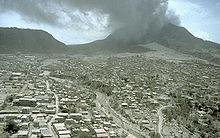Plymouth, Montserrat
Plymouth | |
|---|---|
City | |
 Plymouth was abandoned in 1997 due to a volcanic eruption. | |
 Location of Plymouth within Montserrat. | |
| Country | United Kingdom |
| Overseas territory | Montserrat |
| Population (2007) | |
| • Total | 0 (City completely evacuated due to volcanic eruption) |
| Time zone | UTC-4 (Atlantic) |
Plymouth was the capital as well as the only port of entry to Montserrat, an overseas territory of the United Kingdom located in the Caribbean Sea.
Beginning in July 1995, a series of huge eruptions by the Soufrière Hills volcano sent lava flows and ash falls across a wide area of southern Montserrat, including Plymouth. It was immediately clear that the city was in danger; on 21 August 1995, tephra fell on Plymouth and in December, residents were evacuated as a precaution. They were allowed back a few months later, but on 25 June 1997 a massive eruption produced pyroclastic surges that killed 19 people and reached nearly to the island's airport. Plymouth was again evacuated. Between 4-8 August, a further series of eruptions destroyed approximately 80% of the city, burying it under 1.4 metres (4.6 ft) of ash. This burned many of the buildings therefore making inhabitation nearly impossible for a sizable portion of the residents. The pyroclastic flows had a heavy viscosity of volcanic lava, volcanic ash, and other volcanic rock types that has a density similar to concrete; therefore, removal of the material would take explosives, bulldozers and other resources too expensive for widespread use in any excavation attempt, especially since the land and soil underneath the hardened mud and lava would have been scorched and left completely non-arable by the flow itself.[1] The city was abandoned and the southern half of the island was declared an exclusion area due to the continued activity of Soufrière Hills. The island's government was moved to Brades, though Plymouth still remains the de jure capital since no new capital has been formally created.

The destruction of Plymouth caused severe problems for Montserrat. It was the largest settlement on the island, with around 4,000 inhabitants, and it contained most of the island's shops and services in addition to its seat of government. Some of the lost facilities have been recreated elsewhere on Montserrat, but more than two-thirds of the island's population was evacuated overseas and most of those have never returned.
See also
Footnotes & References
- ^ The difficulty of excavating a buried town may be illustrated by the extinct towns of Pompeii and Herculaneum, which were buried by pyroclastic flows and volcanic ash under similar circumstances; archeological excavation there has taken centuries and will likely never be completed.
